Mother Teresa
For other uses, see Maria Theresa (disambiguation).
| Mother Teresa | |
|---|---|
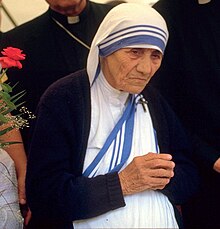
Mother Teresa at a pro-life meeting in 1986 inBonn, West Germany
| |
| Religion | Roman Catholic |
| Institute | Sisters of Loreto (1928–1948) Missionaries of Charity (1950–1997) |
| Personal | |
| Nationality | Ottoman subject (1910–1912) Serbian subject (1912–1915) Bulgarian subject (1915–1918) Yugoslavian subject (1918–1943) Yugoslavian citizen (1943–1948) Indian subject (1948–1950) Indian citizen[1][2] (1948–1997) |
| Born | Anjezë Gonxhe Bojaxhiu 26 August 1910 Üsküp, Kosovo Vilayet, Ottoman Empire (modern Skopje, Macedonia) |
| Died | 5 September 1997 (aged 87) Calcutta, West Bengal, India |
| Senior posting | |
| Title | Superior General |
| Period in office | 1950–1997 |
| Successor | Sister Nirmala Joshi, M.C. |
| Blessed Teresa of Calcutta of theMissionaries of Charity | |
|---|---|
| Virgin, Consecrated religious, Nun | |
| Venerated in | Roman Catholic Church (India) |
| Beatified | 19 October 2003, Saint Peter's Square, Vatican City by Pope John Paul II |
| Major shrine | Mother House of the Missionaries of Charity, Calcutta, West Bengal, India |
| Feast | 5 September |
| Attributes |
|
| Patronage | |
Mother Teresa (26 August 1910 – 5 September 1997) also known as BlessedTeresa of Calcutta, MC,[5] was a Roman Catholic religious sister andmissionary.[6] She was born in Skopje (modern Macedonia), then part of theKosovo Vilayet in the Ottoman Empire. After having lived in Macedonia for eighteen years, she moved to Ireland and then to India, where she lived for most of her life.
Mother Teresa founded the Missionaries of Charity, a Roman Catholic religious congregation, which in 2012 consisted of over 4,500 sisters and was active in 133 countries. They run hospices and homes for people with HIV/AIDS,leprosy and tuberculosis; soup kitchens; dispensaries and mobile clinics; children's and family counselling programmes; orphanages; and schools. Members must adhere to the vows of chastity, poverty, and obedience, as well as a fourth vow, to give "wholehearted free service to the poorest of the poor".[7]
Mother Teresa was the recipient of numerous honours, including the 1979Nobel Peace Prize. In 2003, she was beatified as "Blessed Teresa of Calcutta". A second miracle was credited to her intercession by Pope Francis, in December 2015, paving the way for her to be recognised as a saint by the Roman Catholic Church.[5][8]
A controversial figure both during her life and after her death, Mother Teresa was widely admired by many for her charitable works. She was both praised and criticised for her anti-abortion views.[9][10][11][12] She also received criticism for conditions in the hospices for which she was responsible.[13][14][15][16] Her official biography was written by an Indian civil servant, Navin Chawla, and published in 1992.
Contents
[hide]Early life
| Part of a series on |
| Christianity in India |
|---|
 |
| Indian Christianity portal |
Born Anjezë Gonxhe Bojaxhiu(Albanian: [aˈɲɛzə ˈɡɔndʒɛ bɔjaˈdʒiu];gonxhe meaning "rosebud" or "little flower" in Albanian) on 26 August 1910 into a Kosovar Albanianfamily.[17][18][19][20][21] She considered 27 August, the day she was baptised, to be her "true birthday".[22] Her birthplace of Skopje, now capital of theRepublic of Macedonia, was part of theOttoman Empire until 1918, when it became a part of the Kingdom of Serbs, Croats, and Slovenes.[22][23]
She was the youngest of the children of Nikollë and Dranafile Bojaxhiu (Bernai).[24] Her father, who was involved in the politics of the Albanian community in Macedonia, died in 1919 when she was eight years old.[22][25] Her father may have been from Prizren, Kosovo, while her mother may have been from a village near Gjakova.[26]
According to a biography written by Joan Graff Clucas, in her early years Agnes was fascinated by stories of the lives ofmissionaries and their service in Bengal, and by age 12 had become convinced that she should commit herself to a religious life.[27] Her final resolution was taken on 15 August 1928, while praying at the shrine of the Black Madonna ofVitina-Letnice, where she often went on pilgrimage.[28]
Agnes left home in 1928 at the age of 18 to join the Sisters of Loreto at Loreto Abbey in Rathfarnham, Ireland, to learn English, with a view to becoming a missionary. English was the language the Sisters of Loreto used to teach schoolchildren in India.[29] She never again saw her mother or her sister.[30] Her family continued to live in Skopje until 1934, when they moved to Tirana in Albania.[31]
She arrived in India in 1929, and began her novitiate in Darjeeling, near the Himalayan mountains,[32] where she learntBengali and taught at St. Teresa's School, a schoolhouse close to her convent.[33] She took her first religious vows as a nun on 24 May 1931. At that time she chose to be named after Thérèse de Lisieux, the patron saint of missionaries,[34][35] but because one nun in the convent had already chosen that name, Agnes opted for the Spanish spelling of Teresa.[36]
She took her solemn vows on 14 May 1937, while serving as a teacher at the Loreto convent school in Entally, eastern Calcutta.[22][37][38] Teresa served there for almost twenty years and in 1944 was appointed headmistress.[39]
Although Teresa enjoyed teaching at the school, she was increasingly disturbed by the poverty surrounding her inCalcutta.[40] The Bengal famine of 1943 brought misery and death to the city; and the outbreak of Hindu/Muslim violence in August 1946 plunged the city into despair and horror.[41]
Missionaries of Charity
Main article: Missionaries of Charity
On 10 September 1946, Teresa experienced what she later described as "the call within the call" while travelling by train to the Loreto convent in Darjeeling fromCalcutta for her annual retreat. "I was to leave the convent and help the poor while living among them. It was an order. To fail would have been to break the faith."[42]One author later observed, "Though no one knew it at the time, Sister Teresa had just become Mother Teresa".[43]
She began her missionary work with the poor in 1948, replacing her traditional Loreto habit with a simple white cotton sari decorated with a blue border. Mother Teresa adopted Indian citizenship, spent a few months in Patna to receive a basic medical training in the Holy Family Hospital and then ventured out into the slums.[44][45] Initially, she started a school in Motijhil (Calcutta); soon she started tending to the needs of the destitute and starving.[46] In the beginning of 1949, she was joined in her effort by a group of young women and laid the foundations of a new religious community helping the "poorest among the poor".
Her efforts quickly caught the attention of Indian officials, including the prime minister, who expressed his appreciation.[47]
Teresa wrote in her diary that her first year was fraught with difficulties. She had no income and had to resort to begging for food and supplies. Teresa experienced doubt, loneliness and the temptation to return to the comfort of convent life during these early months. She wrote in her diary:
Teresa received Vatican permission on 7 October 1950 to start the diocesan congregation that would become the Missionaries of Charity.[49] Its mission was to care for, in her own words, "the hungry, the naked, the homeless, the crippled, the blind, the lepers, all those people who feel unwanted, unloved, uncared for throughout society, people that have become a burden to the society and are shunned by everyone."
It began as a small congregation with 13 members in Calcutta; by 1997 it had grown to more than 4,000 sisters running orphanages, AIDS hospices and charity centres worldwide, and caring for refugees, the blind, disabled, aged, alcoholics, the poor and homeless, and victims of floods, epidemics, and famine.[50]
In 1952, Mother Teresa opened the first Home for the Dying in space made available by the city of Calcutta. With the help of Indian officials she converted an abandoned Hindu temple into the Kalighat Home for the Dying, a free hospice for the poor. She renamed it Kalighat, the Home of the Pure Heart (Nirmal Hriday).[51]Those brought to the home received medical attention and were afforded the opportunity to die with dignity, according to the rituals of their faith; Muslims were read the Quran, Hindus received water from the Ganges, and Catholics received the Last Rites.[52] "A beautiful death," she said, "is for people who lived like animals to die like angels—loved and wanted."[52]
Mother Teresa soon opened a home for those suffering from Hansen's disease, commonly known as leprosy, and called the hospice Shanti Nagar (City of Peace).[53] The Missionaries of Charity also established several leprosy outreach clinics throughout Calcutta, providing medication, bandages and food.[54]
As the Missionaries of Charity took in increasing numbers of lost children, Mother Teresa felt the need to create a home for them. In 1955 she opened the Nirmala Shishu Bhavan, the Children's Home of the Immaculate Heart, as a haven for orphans and homeless youth.[55]
The congregation soon began to attract both recruits and charitable donations, and by the 1960s had opened hospices, orphanages and leper houses all over India. Mother Teresa then expanded the congregation throughout the globe. Its first house outside India opened in Venezuela in 1965 with five sisters.[56] Others followed in Rome, Tanzania, and Austria in 1968; during the 1970s the congregation opened houses and foundations in dozens of countries in Asia, Africa, Europe and the United States.[57]
The Missionaries of Charity Brothers was founded in 1963, and a contemplative branch of the Sisters followed in 1976. Lay Catholics and non-Catholics were enrolled in the Co-Workers of Mother Teresa, the Sick and Suffering Co-Workers, and the Lay Missionaries of Charity. In answer to the requests of many priests, in 1981 Mother Teresa also began the Corpus Christi Movement for Priests,[58] and in 1984 founded with Fr. Joseph Langford the Missionaries of Charity Fathers[59] to combine the vocational aims of the Missionaries of Charity with the resources of the ministerial priesthood. By 2007 the Missionaries of Charity numbered approximately 450 brothers and 5,000 sisters worldwide, operating 600 missions, schools and shelters in 120 countries.[60]
International charity
Mother Teresa said "By blood, I am Albanian. By citizenship, an Indian. By faith, I am a Catholic nun. As to my calling, I belong to the world. As to my heart, I belong entirely to the Heart of Jesus."[2]
In 1982, at the height of the Siege of Beirut, Mother Teresa rescued 37 children trapped in a front line hospital by brokering a temporary cease-fire between the Israeli army and Palestinian guerrillas.[61] Accompanied by Red Cross workers, she travelled through the war zone to the devastated hospital to evacuate the young patients.[62]
When Eastern Europe experienced increased openness in the late 1980s, she expanded her efforts to Communist countries that had previously rejected the Missionaries of Charity, embarking on dozens of projects. She was undeterred by criticism about her firm stand against abortion and divorce stating, "No matter who says what, you should accept it with a smile and do your own work." She visited the Soviet republic of Armenia following the 1988 earthquake,[63] and met withNikolai Ryzhkov, the Chairman of the Council of Ministers.[64]
Mother Teresa travelled to assist and minister to the hungry in Ethiopia, radiation victims at Chernobyl, and earthquake victims in Armenia.[65][66][67] In 1991, Mother Teresa returned for the first time to her homeland and opened a Missionaries of Charity Brothers home in Tirana, Albania.
By 1996, Mother Teresa was operating 517 missions in more than 100 countries.[68] Over the years, Mother Teresa's Missionaries of Charity grew from twelve to thousands serving the "poorest of the poor" in 450 centres around the world. The first Missionaries of Charity home in the United States was established in the South Bronx, New York; by 1984 the congregation operated 19 establishments throughout the country.[69] Mother Teresa was fluent in five languages: Bengali,[70]Albanian, Serbian, English, and Hindi.[71]
Declining health and death
Mother Teresa suffered a heart attack in Rome in 1983 while visiting Pope John Paul II. After a second attack in 1989, she received an artificial pacemaker. In 1991, after having pneumonia while in Mexico, she suffered further heart problems. She offered to resign her position as head of the Missionaries of Charity, but the sisters of the congregation, in a secret ballot, voted for her to stay. Mother Teresa agreed to continue her work as head of the congregation.[72]
In April 1996, Mother Teresa fell and broke her collar bone. In August she suffered from malaria and failure of the left heart ventricle. She had heart surgery but it was clear that her health was declining. The Archbishop of Calcutta, Henry Sebastian D'Souza, said he ordered a priest to perform an exorcism on Mother Teresa with her permission when she was first hospitalised with cardiac problems because he thought she may be under attack by the devil.[73]
Christopher Hitchens accused her of hypocrisy for opting to receive advanced treatment for her heart condition.[74][75]
On 13 March 1997, she stepped down from the head of Missionaries of Charity. She died on 5 September 1997.[76]
At the time of her death, Mother Teresa's Missionaries of Charity had over 4,000 sisters, and an associated brotherhood of 300 members, operating 610 missions in 123 countries.[77] These included hospices and homes for people with HIV/AIDS, leprosy and tuberculosis, soup kitchens, children's and family counselling programmes, personal helpers, orphanages, and schools. The Missionaries of Charity were also aided by Co-Workers, who numbered over 1 million by the 1990s.[78]
Mother Teresa lay in repose in St Thomas, Calcutta for one week prior to her funeral, in September 1997. She was granted a state funeral by the Indian government in gratitude for her services to the poor of all religions in India.[79] Her death was mourned in both secular and religious communities. In tribute, Nawaz Sharif, the Prime Minister of Pakistan, said that she was "a rare and unique individual who lived long for higher purposes. Her life-long devotion to the care of the poor, the sick, and the disadvantaged was one of the highest examples of service to our humanity."[80] The former U.N. Secretary-GeneralJavier Pérez de Cuéllar said: "She is the United Nations. She is peace in the world."[80]
Recognition and reception
In India
Mother Teresa had first been recognised by the Indian government more than a third of a century earlier when she was awarded the Padma Shri in 1962 and the Jawaharlal Nehru Award for International Understanding in 1969.[81] She continued to receive major Indian awards in subsequent years, including India's highest civilian award, the Bharat Ratna, in 1980.[82] Her official biography was written by an Indian civil servant, Navin Chawla, and published in 1992.[83]
On 28 August 2010, to commemorate the 100th anniversary of her birth, the government of India issued a special 5 Rupee coin, being the sum she first arrived in India with. President Pratibha Patil said of Mother Teresa, "Clad in a white sari with a blue border, she and the sisters of Missionaries of Charity became a symbol of hope to many – the aged, the destitute, the unemployed, the diseased, the terminally ill, and those abandoned by their families."[84]
Indian views on Mother Teresa were not uniformly favourable. Aroup Chatterjee, who was born and raised in Calcutta but lived in London, reports that "she was not a significant entity in Calcutta in her lifetime". Chatterjee blames Mother Teresa for promoting a negative image of Calcutta, exaggerating the work done by her Mission, and misusing the funds and privileges at her disposal.[85]
Her presence and profile grated in parts of the Indian political world, as she often opposed the Hindu Right. The Bharatiya Janata Party clashed with her over the Christian Dalits, but praised her in death, sending a representative to her funeral. The Vishwa Hindu Parishad, on the other hand, opposed the government's decision to grant her a state funeral. Its secretary Giriraj Kishore said that "her first duty was to the Church and social service was incidental" and accused her of favouring Christians and conducting "secret baptisms" of the dying.[86][87] In its front page tribute, the Indian fortnightlyFrontline dismissed these charges as "patently false" and said that they had "made no impact on the public perception of her work, especially in Calcutta". Although praising her "selfless caring", energy and bravery, the author of the tribute was critical of Mother Teresa's public campaigning against abortion and that she claimed to be non-political when doing so.[88]
In February 2015, Mohan Bhagwat, leader of the Hindu right-wing organisation Rashtriya Swayamsevak Sangh, said that her objective was "to convert the person, who was being served, into a Christian"[89] Former RSS spokesperson MG Vaidhya backed Bhagwat's remarks. The party accused the media of "distorting facts about Bhagwat's remarks". Trinamool Congress MP Derek O'Brien, CPI leader Atul Anjan and Delhi's chief minister Arvind Kejriwal protested against the remarks.[90]
In the rest of the world
In 1962, Mother Teresa received the Philippines-based Ramon Magsaysay Awardfor International Understanding, given for work in South or East Asia. The citation said that "the Board of Trustees recognises her merciful cognisance of the abject poor of a foreign land, in whose service she has led a new congregation".[91] By the early 1970s, Mother Teresa had become an international celebrity. Her fame can be in large part attributed to the 1969 documentary Something Beautiful for God, which was filmed by Malcolm Muggeridge and his 1971 book of the same title. Muggeridge was undergoing a spiritual journey of his own at the time.[92] During the filming of the documentary, footage taken in poor lighting conditions, particularly the Home for the Dying, was thought unlikely to be of usable quality by the crew. After returning from India, however, the footage was found to be extremely well lit. Muggeridge claimed this was a miracle of "divine light" from Mother Teresa herself.[93] Others in the crew thought it was due to a new type of ultra-sensitive Kodak film.[94] Muggeridge later converted to Catholicism.
Around this time, the Catholic world began to honour Mother Teresa publicly. In 1971, Paul VI awarded her the first Pope John XXIII Peace Prize, commending her for her work with the poor, display of Christian charity and efforts for peace.[95]She later received the Pacem in Terris Award (1976).[96] Since her death, Mother Teresa has progressed rapidly along the steps towards sainthood, currently having reached the stage of having been beatified.
Mother Teresa was honoured by both governments and civilian organisations. She was appointed an honorary Companion of the Order of Australia in 1982, "for service to the community of Australia and humanity at large."[97] The United Kingdom and the United States each repeatedly granted awards, culminating in the Order of Merit in 1983, and honorary citizenship of the United States received on 16 November 1996.[98] Mother Teresa's Albanian homeland granted her the Golden Honour of the Nation in 1994.[88] Her acceptance of this and the Haitian Legion of Honour proved controversial. Mother Teresa attracted criticism from a number of people for implicitly giving support to the Duvaliers and to corrupt businessmen such as Charles Keating and Robert Maxwell. In Keating's case she wrote to the judge of his trial asking for clemency to be shown.[16][88]
Universities in both the West and in India granted her honorary degrees.[88] Other civilian awards include the Balzan Prizefor promoting humanity, peace and brotherhood among peoples (1978),[99] and the Albert Schweitzer International Prize (1975).[100] In April 1976, Mother Teresa visited the University of Scranton in northeastern Pennsylvania where she was awarded the La Storta Medal for Human Service by the University’s President Rev. William Byron, S.J.[101] While there, she also addressed a crowd of 4,500 people. In her speech, she called the audience to "know poor people in your own home and local neighborhood," whether it meant feeding others or simply spreading joy and love.[102] She continued, stating that "the poor will help us grow in sanctity, for they are Christ in the guise of distress," calling the students and residents of the city of Scranton to give to suffering members in their community.[101] Again, in August 1987, Mother Teresa visited the University of Scranton and was awarded an honorary doctor of social science degree in recognition of her selfless service and her ministry to help the destitute and sick.[103] She also spoke to the students as well as members of the Diocese of Scranton, numbering over 4000 individuals,[104] telling them about her service to the "poorest of the poor" and instructing them to "do small things with great love."[105]
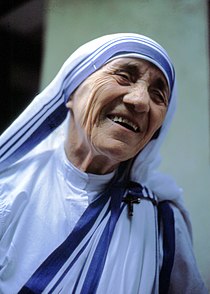 | |
In 1979, Mother Teresa was awarded the Nobel Peace Prize, "for work undertaken in the struggle to overcome poverty and distress, which also constitutes a threat to peace." She refused the conventional ceremonial banquet given to laureates, and asked that the $192,000 funds be given to the poor in India,[106] stating that earthly rewards were important only if they helped her help the world's needy. When Mother Teresa received the prize, she was asked, "What can we do to promote world peace?" She answered "Go home and love your family." Building on this theme in her Nobel Lecture, she said: "Around the world, not only in the poor countries, but I found the poverty of the West so much more difficult to remove. When I pick up a person from the street, hungry, I give him a plate of rice, a piece of bread, I have satisfied. I have removed that hunger. But a person that is shut out, that feels unwanted, unloved, terrified, the person that has been thrown out from society—that poverty is so hurtable [sic] and so much, and I find that very difficult." She also singled out abortion as "the greatest destroyer of peace today. Because if a mother can kill her own child – what is left for me to kill you and you kill me – there is nothing between."[107]
After the award of the Nobel Peace Prize Teresa was criticised for promoting the Church's moral teachings on abortion and contraception, which some felt diverted funds from more effective methods of solving India's problems.[13] At the Fourth World Conference on Women in Beijing, Teresa stated "Yet we can destroy this gift of motherhood, especially by the evil of abortion, but also by thinking that other things like jobs or positions are more important than loving." [108]
During her lifetime, Mother Teresa was named 18 times in the yearly Gallup's most admired man and woman poll as one of the ten women around the world that Americans admired most, finishing first several times in the 1980s and 1990s.[109] In 1999, a poll of Americans ranked her first in Gallup's List of Most Widely Admired People of the 20th Century.[110] In that survey, she out-polled all other volunteered answers by a wide margin, and was in first place in all major demographic categories except the very young.[110][111]
Criticism
Main article: Criticism of Mother Teresa
Mother Teresa believed suffering – even when caused by poverty, medical problems, or starvation – was a gift from God. As a result, while her clinics received millions of dollars in donations, their conditions drew criticism from people disturbed by the shortage of medical care, systematic diagnosis, and necessary nutrition, as well as the scarcity of analgesics for those in pain.[112][113][114] Some have argued that the additional money could have had transformative effects on the health of the poor by creating advanced palliative care facilities in the city.[115][116] Pro-choice groups criticised her stance on abortion,[117][118][119] while pro-life advocates praised her support of fetal rights.[9][10][120][12]
One of Mother Teresa's most outspoken critics was the English journalist and literary critic Christopher Hitchens, who wrote the extended essay The Missionary Position: Mother Teresa in Theory and Practice (1995) and wrote in a 2003 article, "This returns us to the medieval corruption of the church, which sold indulgences to the rich while preaching hellfire and continence to the poor. [Mother Teresa] was not a friend of the poor. She was a friend of poverty. She said that suffering was a gift from God. She spent her life opposing the only known cure for poverty, which is the empowerment of women and the emancipation of them from a livestock version of compulsory reproduction."[121]
Spiritual life
Analysing her deeds and achievements, John Paul II asked: "Where did Mother Teresa find the strength and perseverance to place herself completely at the service of others? She found it in prayer and in the silent contemplation of Jesus Christ, his Holy Face, his Sacred Heart."[122] Privately, Mother Teresa experienced doubts and struggles over her religious beliefs which lasted nearly 50 years until the end of her life, during which "she felt no presence of God whatsoever", "neither in her heart or in the eucharist" as put by her postulator Rev. Brian Kolodiejchuk.[123] Mother Teresa expressed grave doubts about God's existence and pain over her lack of faith:
With reference to the above words, the Rev. Brian Kolodiejchuk, her postulator (the official responsible for gathering the evidence for her sanctification) said he thought that some might misinterpret her meaning, but her faith that God was working through her remained undiminished, and that while she pined for the lost sentiment of closeness with God, she did not question his existence.[125] and that she may have experienced something similar to what is believed of Jesus Christ when crucified who was heard to say "Eli Eli lama sabachthani?" which is translated to "My God, My God, why have you forsaken me?" Brian Kolodiejchuk, drew comparisons to the 16th century mystic St. John of the Cross, who coined the term the "Dark Night of the Soul".[92] Many other saints had similar experiences of spiritual dryness, or what Catholics believe to be spiritual tests ("passive purifications"), such as Mother Teresa's namesake, St. Therese of Lisieux, who called it a "night of nothingness."[125] Rev. James Langford said these doubts were typical and would not be an impediment to canonisation.[125]
Mother Teresa described, after ten years of doubt, a short period of renewed faith. At the time of the death of Pope Pius XIIin the fall of 1958, praying for him at a requiem mass, she said she had been relieved of "the long darkness: that strange suffering." However, five weeks later, she described returning to her difficulties in believing.[126]
Mother Teresa wrote many letters to her confessors and superiors over a 66-year period, most notably to Calcutta Archbishop Ferdinand Perier and a Jesuit priest, Celeste van Exem, who had been her spiritual advisor since the formation of the Missionaries of Charity.[127] She had asked that her letters be destroyed, concerned that "people will think more of me—less of Jesus."[92][128] Despite this request, the correspondences have been compiled in Mother Teresa: Come Be My Light (Doubleday).[92][129] In one publicly released letter to a spiritual confidant, the Rev. Michael van der Peet, she wrote, "Jesus has a very special love for you. [But] as for me, the silence and the emptiness is so great, that I look and do not see,—Listen and do not hear—the tongue moves [in prayer] but does not speak ... I want you to pray for me—that I let Him have [a] free hand."
In his first encyclical Deus caritas est, Benedict XVI mentioned Teresa of Calcutta three times and he also used her life to clarify one of his main points of the encyclical. "In the example of Blessed Teresa of Calcutta we have a clear illustration of the fact that time devoted to God in prayer not only does not detract from effective and loving service to our neighbour but is in fact the inexhaustible source of that service."[130] Mother Teresa specified that "It is only by mental prayer and spiritual reading that we can cultivate the gift of prayer."[131]
Although there was no direct connection between Mother Teresa's order and the Franciscan orders, she was known as a great admirer of St. Francis of Assisi.[132] Accordingly, her influence and life show influences of Franciscan spirituality. The Sisters of Charity recite the peace prayer of St. Francis every morning during thanksgiving after Communion and many of the vows and emphasis of her ministry are similar.[132] St. Francis emphasised poverty, chastity, obedience and submission to Christ. He also devoted much of his own life to service of the poor, especially lepers in the area where he lived.
Sainthood
Miracle and beatification
After Mother Teresa's death in 1997, the Holy See began the process of beatification, the third step toward possiblecanonisation. This process requires the documentation of a miracle performed from the intercession of Mother Teresa.[133]
In 2002, the Vatican recognised as a miracle the healing of a tumour in the abdomen of an Indian woman, Monica Besra, after the application of a locket containing Mother Teresa's picture. Besra said that a beam of light emanated from the picture, curing the cancerous tumour. Some of Besra's medical staff and Besra's husband said that conventional medical treatment had eradicated the tumour.[134] Dr. Ranjan Mustafi, who told The New York Times he had treated Besra, said that the cyst was not cancer at all but a cyst caused by tuberculosis. He said, "It was not a miracle.... She took medicines for nine months to one year."[135] According to Besra's husband, "My wife was cured by the doctors and not by any miracle."[136] Besra's medical records contain sonograms, prescriptions, and physicians' notes and could provide evidence on whether the cure was a miracle or not. Besra has claimed that Sister Betta of the Missionaries of Charity is withholding them. The officials at the Balurghat Hospital where Besra was seeking medical treatment have claimed that they are being pressured by the Catholic order to declare the cure a miracle.[136]
Christopher Hitchens was the only witness as far as he knew, called by the Vatican to give evidence against Mother Teresa's beatification and canonisation process,[137] because the Vatican had abolished the traditional "devil's advocate" role, which fulfilled a similar purpose.[138] Hitchens has argued that "her intention was not to help people," and he alleged that she lied to donors about the use of their contributions. "It was by talking to her that I discovered, and she assured me, that she wasn't working to alleviate poverty," says Hitchens. "She was working to expand the number of Catholics. She said, 'I'm not a social worker. I don't do it for this reason. I do it for Christ. I do it for the church.'"[139]
In the process of examining Teresa's suitability for beatification and canonisation, the Roman Curia (the Vatican) studied a great deal of published and unpublished criticism of her life and work. Concerning allegations raised by journalistChristopher Hitchens, Vatican officials have responded by saying that these have been investigated by the agency charged with such matters, the Congregation for the Causes of Saints, and that they found no obstacle to Mother Teresa's beatification. Because of the attacks she has received, some Catholic writers have called her a sign of contradiction.[140]The beatification of Mother Teresa took place on 19 October 2003, thereby bestowing on her the title "Blessed."[141]
Canonisation
On 17 December 2015, the Vatican confirmed that Pope Francis recognised a second miracle attributed to her involving the healing of a Brazilian man with multiple brain tumors.[8] The Vatican has set 4 September 2016 as the canonisation date for Teresa.
Legacy and depictions in popular culture
Commemoration
Main article: Commemorations of Mother Teresa
Mother Teresa inspired a variety of commemorations. She has been memorialised through museums, been named patroness of various churches, and had various structures and roads named after her, including Albania's international airport. Mother Teresa Day (Dita e Nënë Terezës) on 19 October is a public holiday in Albania. In 2009 the Memorial House of Mother Teresa was opened in her hometown Skopje, in Macedonia. The Roman Catholic cathedral in Pristina is also dedicated in her honour. Its construction sparked controversy in Muslim circles in 2011; local Muslim leaders claimed that the cathedral was too large for Pristina's small Catholic community and complained that most Muslim places of worship in the city were far smaller. An initiative to erect a monument to Mother Teresa in the town of Peć that same year was also protested by some Albanian Muslims. A youth group calling itself the Muslim Youth Forum started a petition demanding that a monument to Albanian veterans of the Kosovo War be erected instead, and collected some 2,000 signatures by May 2011. The Muslim Youth Forum claimed that the building of a Mother Teresa monument would represent an insult to the town's Muslim community, which makes up about 98 percent of the population. Noli Zhita, the group's spokesperson, claimed that Mother Teresa was not an Albanian but a Vlach from Macedonia. He described the monument's planned construction as part of a plot to "Christianise" Kosovo. The Mayor of Peć, Ali Berisha, voiced support for the monument's construction and indicated that the head of the Islamic community in the town had not raised any objections.[142]
Mother Teresa Women's University,[143] Kodaikanal, Tamil Nadu, has been established in 1984 as a public university bygovernment of Tamil Nadu, India.
Mother Theresa Post Graduate and Research Institute of Health Sciences,[144] Pondicherry has been established in 1999 by Government of Puducherry, India.
The charitable organisation Sevalaya runs the Mother Teresa Girls Home, named in her honour and designed to provide poor and orphan girls children in the vicinity of the underserved Kasuva village in Tamil Nadu with free food, clothing, shelter, and education.[145]
Various tributes have been published in Indian newspapers and magazines written by her biographer, Navin Chawla.[146][147][148][149][150][151][152]
Indian Railways introduced a new train, "Mother Express", named after Mother Teresa, on 26 August 2010 to mark her birth centenary.[153]
The Tamil Nadu State government organised centenary celebrations of Mother Teresa on 4 December 2010 in Chennai, headed by Tamil Nadu chief minister M Karunanidhi.[154][155]
Beginning 5 September 2013, the anniversary of her death has been designated as the International Day of Charity by theUnited Nations General Assembly.[156]
Film and literature
Documentaries
- Mother Teresa is the subject of the 1969 documentary film and 1972 book Something Beautiful for God by Malcolm Muggeridge. This film is often credited with having called the Western world's attention to Mother Teresa.
- Christopher Hitchens' 1994 documentary about her, Hell's Angel, claims that she urged the poor to accept their fate, while the rich are portrayed as being favoured by God.[157][158] It had a tie-in book entitled The Missionary Position : Mother Teresa in Theory and Practice.
Drama films or television
- Actress Geraldine Chaplin played Mother Teresa in Mother Teresa: In the Name of God's Poor which won an 1997 Art Film Festival award.
- Mother Teresa was played by Olivia Hussey in a 2003 Italian television miniseries titled Mother Teresa of Calcutta. This was re-released in 2007 and received a CAMIE award.
- Mother Teresa was played by Juliet Stevenson in the 2014 film The Letters which is heavily based on her letters to Vatican priest Celeste van Exem.
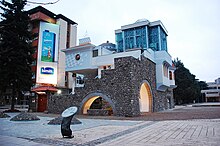
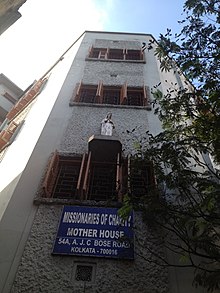
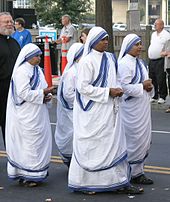


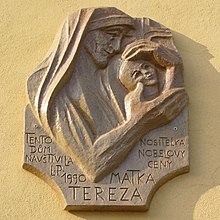
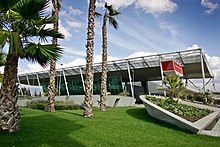
Check the source DigitalEssay.net This site is really helped me out gave me relief from essay headaches. Good luck!
ReplyDelete